This easy mango modak recipe is a delightful fusion of traditional taste and tropical flavor, making it an ideal sweet for Ganesh Chaturthi celebrations. With just six readily available ingredients, you can create soft, creamy modaks bursting with the juicy essence of ripe mangoes. The process is simple and doesn’t involve any tricky steps or advanced cooking skills, making it perfect even for beginners or busy home cooks.
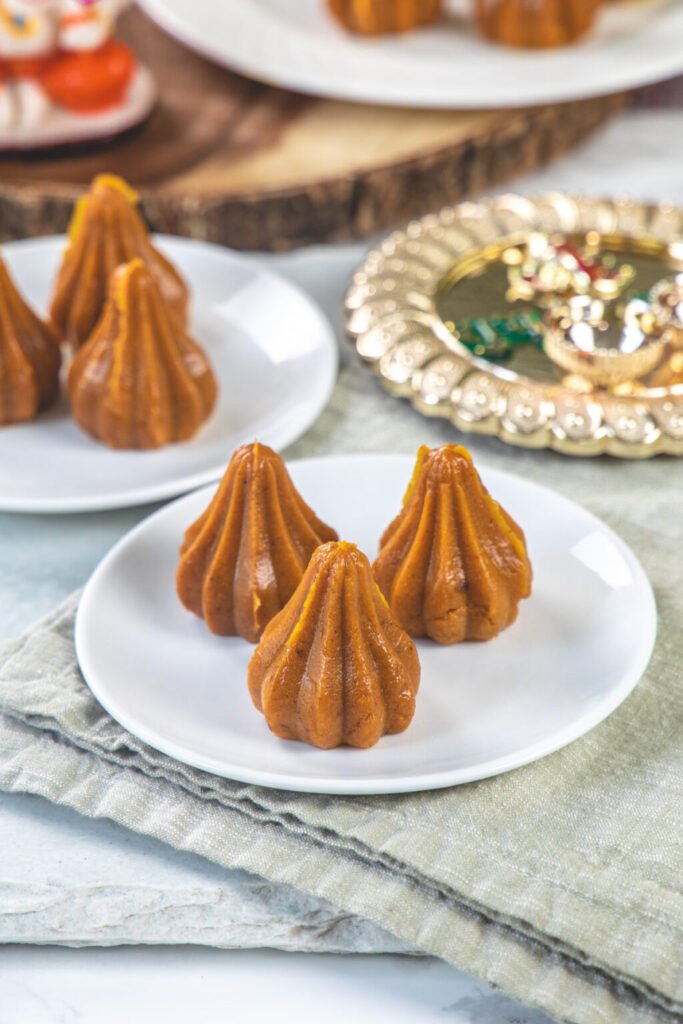
Whether you’re preparing bhog for Lord Ganesha or just want a fruity twist on a classic Indian mithai, these mango modaks are sure to win hearts with their bright color, natural sweetness, and melt-in-the-mouth texture. A festive treat the whole family will enjoy! These mango modaks are sweet, aromatic, and melt in your mouth—ideal for celebrations or as a fruity twist on traditional Indian sweets.
The smooth mango pulp blends beautifully with mawa (khoya), creating a luscious base that’s further enhanced with a hint of cardamom for a warm, aromatic touch. A small amount of ghee adds a subtle richness and helps in shaping the mixture easily. These modaks are not only eye-catching but also melt-in-your-mouth delicious. Whether you’re making them as an offering for Lord Ganesha or simply craving something sweet and fruity, this mango modak recipe delivers festive flavor in every bite.
About This Mango Modak Recipe
- This mango modak recipe brings together the rich taste of traditional peda and the tropical sweetness of mangoes, creating a delicious festive treat with a fruity twist. The flavor is reminiscent of modak peda, but with the bright, vibrant essence of ripe mangoes taking center stage. It requires about 30 to 45 minutes from start to finish, but every minute spent is absolutely worth it, especially when you’re making a heartfelt offering to Lord Ganesha during Ganesh Chaturthi.
- This recipe is beginner-friendly and completely foolproof. You don’t need to be an expert in Indian sweets or have any prior experience with modak preparation. The steps are easy to follow and result in smooth, melt-in-the-mouth modaks every time.
- Worried about the shape? Don’t be! This version uses a simple modak mould that helps you achieve perfect, festive shapes without much effort. Just lightly grease the mould with ghee, fill it with the mixture, and gently demould a beautiful mango modak every time.
- And if you don’t have a modak mould at home, no problem at all! Simply roll the prepared mixture into small, round ladoos. They’ll taste just as delicious and still serve as a wonderful offering to Bappa.
- Whether you’re preparing prasad or simply indulging your sweet tooth, these mango modaks are sure to add color, flavor, and devotion to your celebration. The recipe calls for just a few ingredients, requires no advanced cooking techniques, and guarantees soft, flavorful results that both kids and adults will enjoy.
Ingredient Notes:
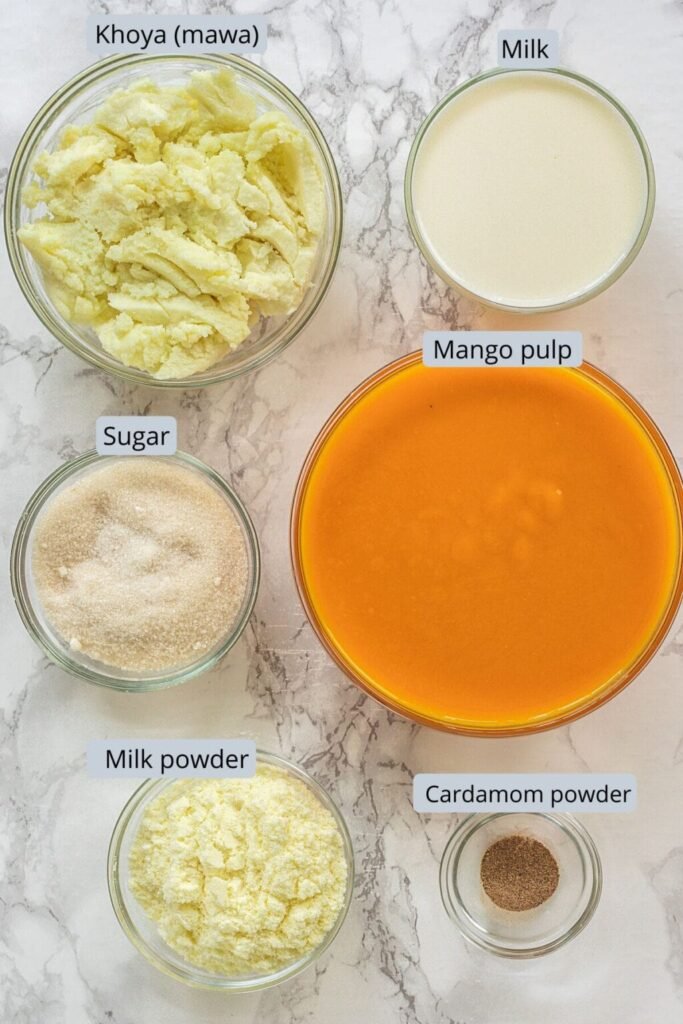
- Khoya (Mawa): To save time during festive preparations, I usually go for store-bought khoya, which is conveniently available in most Indian grocery stores. You’ll often find it in the dairy section, though sometimes it’s stocked in the freezer. It brings rich, authentic flavor to the modak. If you prefer a homemade touch, you can make khoya from scratch by slowly simmering milk until it thickens. Alternatively, I also have a quick and easy instant mawa recipe that comes in handy during busy festivals.
- Mango Pulp: The star ingredient of this recipe! Fresh mango pulp, when in season, gives the best flavor and natural sweetness. Choose ripe, juicy mangoes for the most vibrant taste. However, if fresh mangoes aren’t available, canned mango pulp is a convenient and reliable alternative. Alphonso mango pulp adds vibrant color and a sweet, fruity aroma to the modak.
- Sugar: Adjust the sugar based on how sweet your mango pulp is—less for naturally sweet pulp, more if it’s slightly tangy. Always taste the pulp first—if it’s already sweet enough, reduce the sugar slightly. This way, your modak won’t be overly sweet, and you’ll get a perfect balance of flavors.
- Milk Powder: For this recipe, I recommend using full-fat milk powder, which is easily found in Indian grocery stores. It adds a creamy richness to the mixture. Be sure not to use non-fat milk powder, commonly found in American supermarkets, as it doesn’t deliver the same texture or taste.
- Cardamom Powder: A small pinch of cardamom powder lifts the entire flavor profile of the mango modak. It adds a delightful sweetness and classic Indian dessert aroma that perfectly enhances the mango flavor.
How To Make Mango Modak?
1) Add the grated or crumbled khoya along with milk to a non-stick or heavy-based pan. Using a thick-bottomed vessel ensures even heating and avoids burning during the slow cooking process. This type of pan helps distribute heat evenly, preventing the mixture from sticking or scorching during cooking. Place the pan on medium heat and let the mixture slowly heat up. This gentle warming helps melt the khoya evenly, ensuring it doesn’t stick or burn at the bottom as the cooking begins.
2) Stir the mixture gently. As the khoya heats up, it will gradually melt and blend with the milk to form a smooth, lump-free liquid-like consistency.
3) Continue stirring constantly to avoid sticking or burning at the bottom. This cooking phase may take around 10 to 20 minutes, depending on how moist your khoya is. Moist khoya melts faster.
4) Continue cooking the mixture over medium heat, stirring continuously. As it thickens, the moisture will begin to evaporate, and the bubbling will gradually subside. Once the mixture becomes dense, leaves the sides of the pan, and no longer produces much steam, it’s a sign that it’s ready. At this stage, transfer the thickened khoya mixture onto a plate and allow it to cool slightly before proceeding with the next steps.
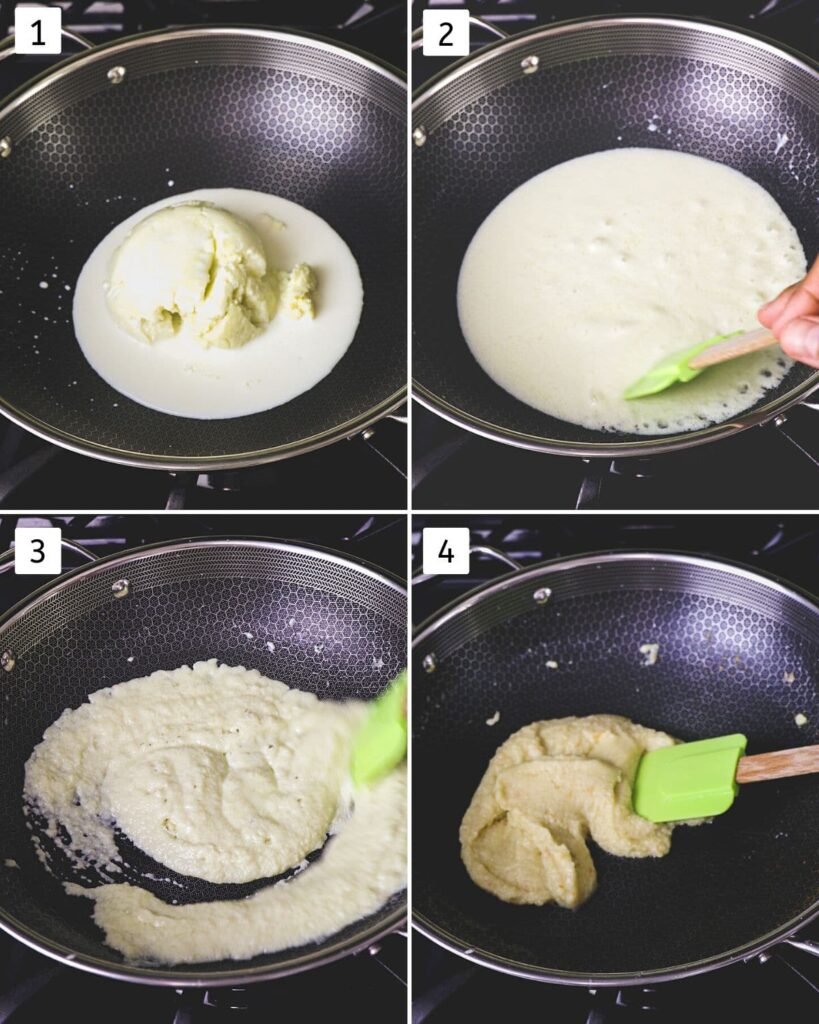
5) In the same pan, pour in fresh or canned mango pulp, followed by the required quantity of sugar (adjust according to the sweetness of the pulp).
6) Mix the pulp and sugar thoroughly. Start cooking on medium heat while stirring continuously so the sugar dissolves and integrates well with the pulp.
7) Keep scraping down the sides and bottom of the pan as the mixture cooks to prevent it from sticking or burning. Stirring ensures even cooking.
8) Cook until the mixture reduces to a thick, jam-like texture. It should not be runny—when lifted, it should coat the back of a spoon or spatula. This may take approximately 15 minutes.
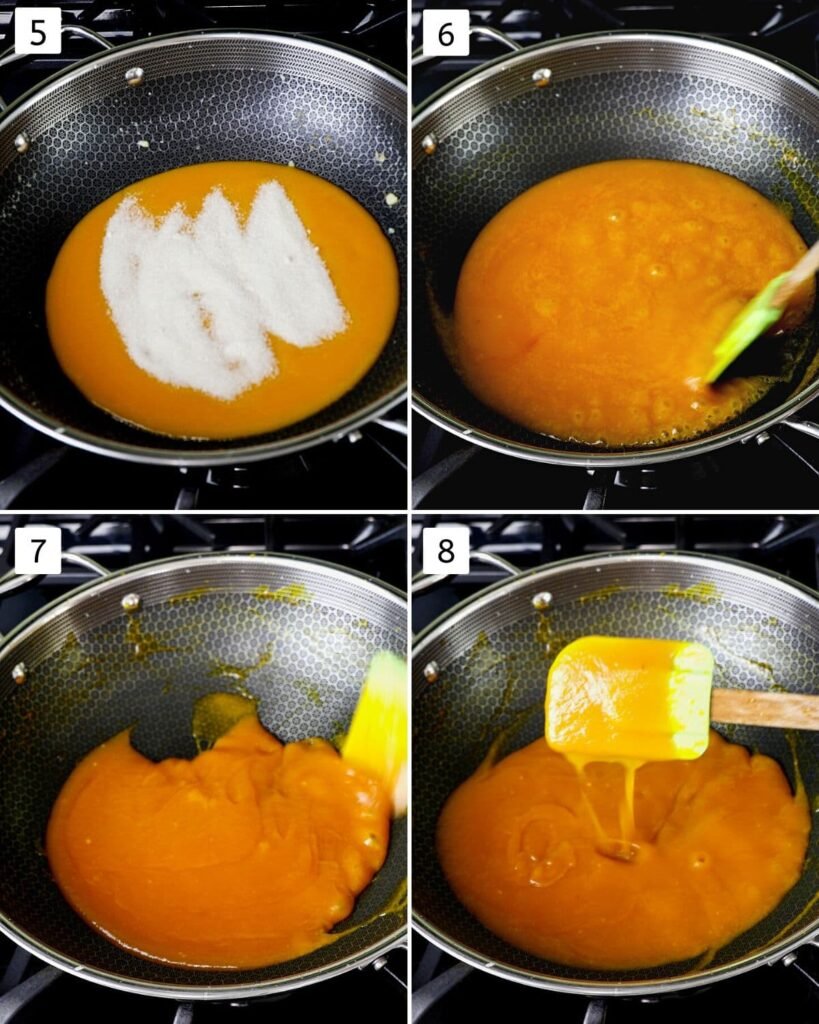
9) Now, add the cooked khoya and a pinch of cardamom powder to the thickened mango pulp for a boost of flavor and aroma.
10) Stir thoroughly until the khoya and milk blend into a smooth, consistent mixture without any lumps.
11) Add the milk powder, which helps in binding and gives a richer texture.
12) Stir again until the milk powder is fully incorporated.
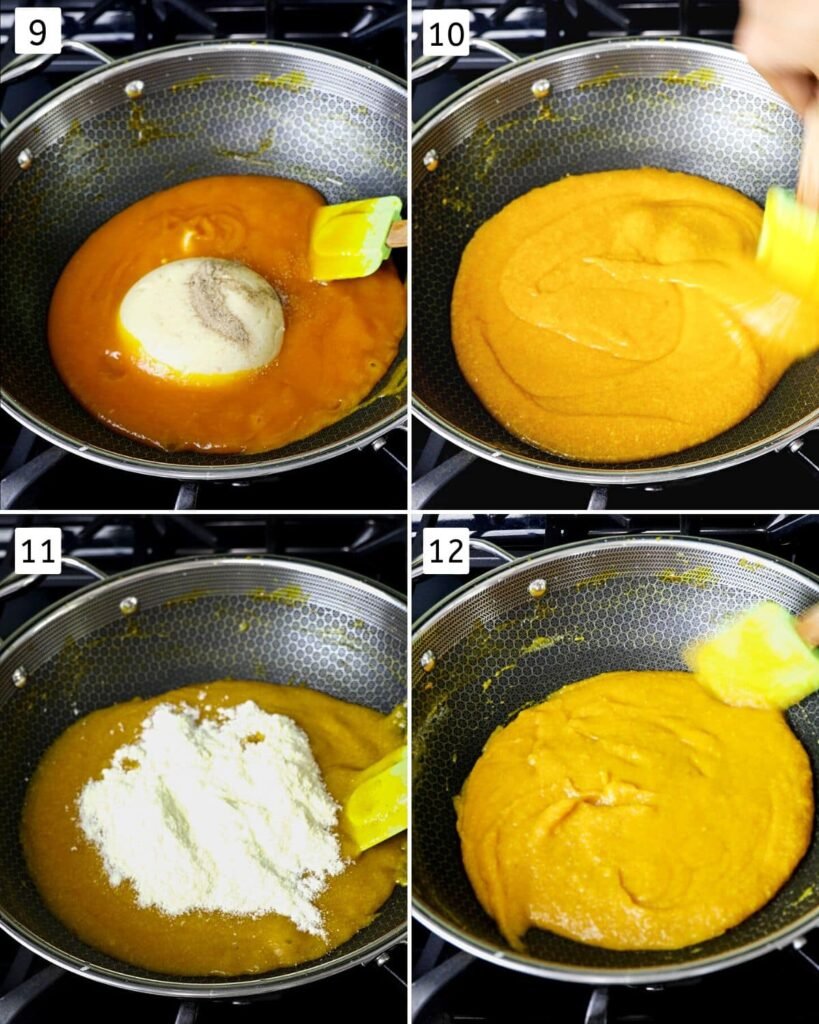
13) Keep stirring over medium heat, ensuring the mixture cooks evenly and doesn’t stick to the base.
14) After 8 to 10 minutes, the entire mixture will begin to come together like a soft dough and will start leaving the sides of the pan. This is the perfect consistency for shaping.
15) Remove the cooked mixture onto a plate and allow it to cool just enough so that it’s easy to handle with your hands.
16) While the mixture cools, grease your modak mould with a bit of ghee so that the modaks release easily without sticking.
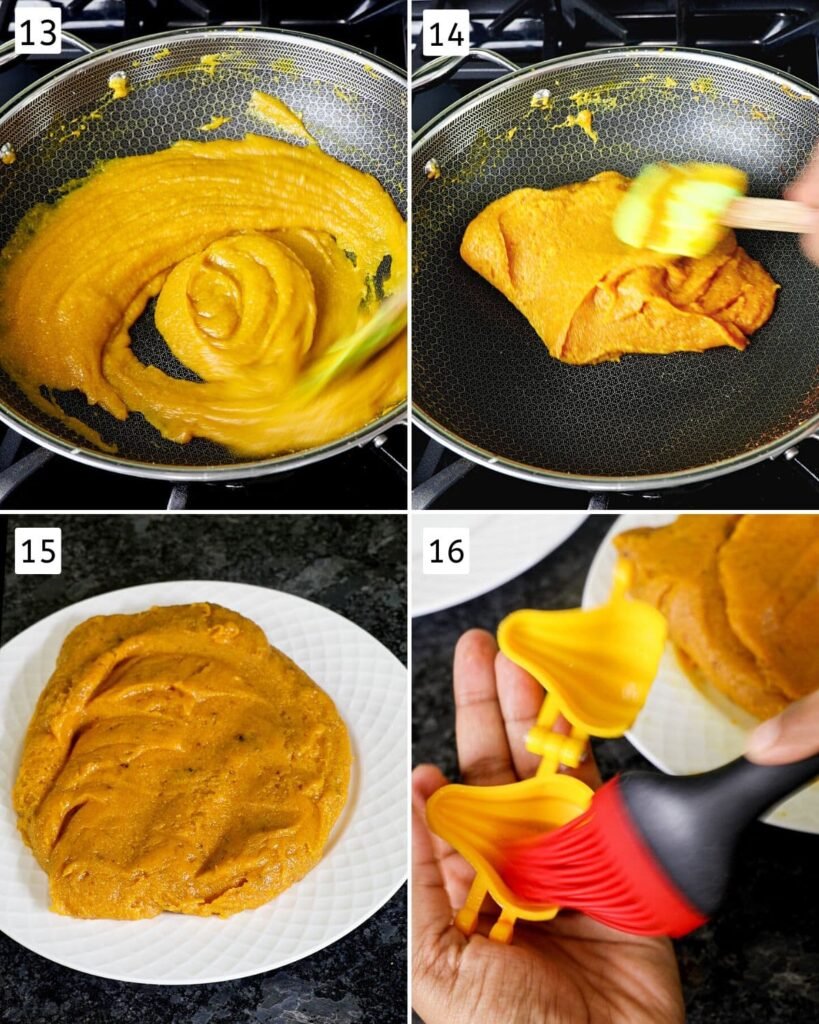
17) Close the mould and take a portion of the mixture. Shape it roughly into an oval and gently press it into the mould cavity, ensuring all the crevices are filled.
18) Firmly pack the mixture into the mould, then use your fingers to gently flatten and smooth the bottom, ensuring an even, stable base for the modak.
19) Carefully open the mould, taking your time to gently release the modak so it retains its delicate shape without any cracks or breaks.
20) Gently lift the mango modak from the mould and place it on a serving plate, ensuring it stays intact and retains its beautiful shape. Repeat the shaping process with the remaining mixture.
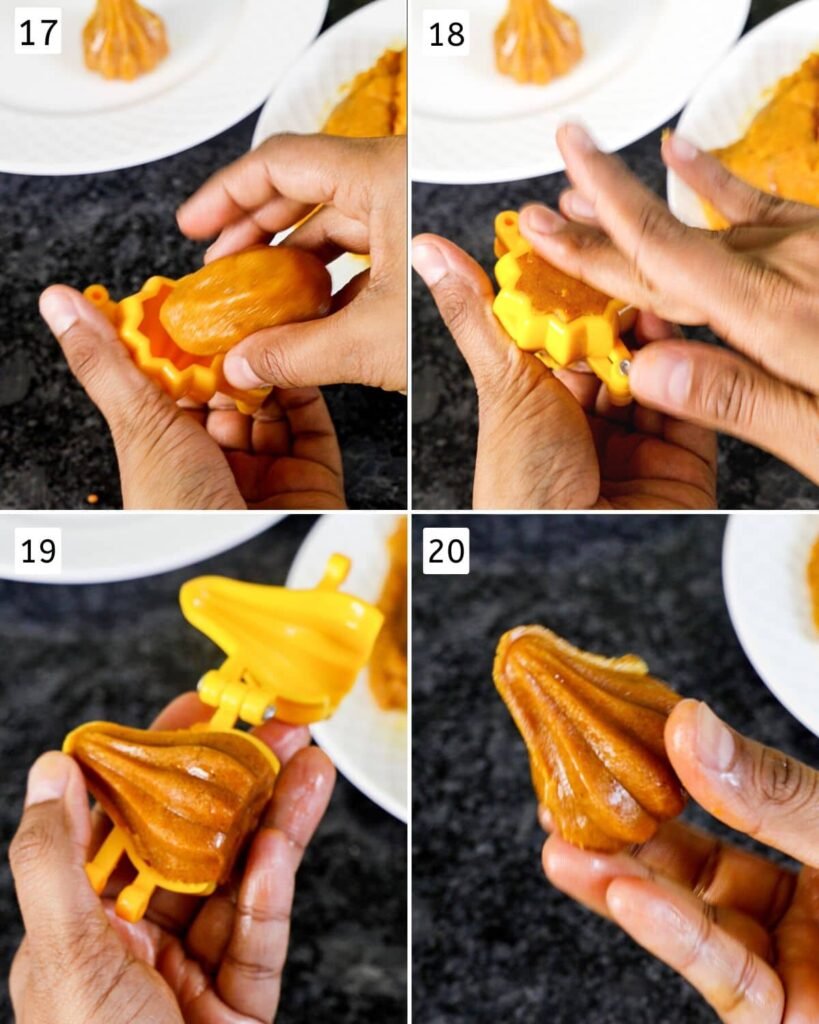
Expert Tips:
- Avoid Overcooking the Mixture: Be attentive while cooking the mango and khoya mixture. Overcooking can cause the mixture to become too dry and result in hard, chewy modaks. Switch off the heat when the mixture leaves the pan’s sides and forms a soft, dough-like texture.
- Adjust Sugar Based on Mango Sweetness: Always taste your mango pulp before adding sugar. If you’re using fresh, sweet Alphonso mangoes, you may need less sugar. On the other hand, if you’re using canned mango pulp—especially if it’s already sweetened—significantly reduce the sugar quantity to avoid an overly sweet taste.
- Color May Vary with Mango Type: The final hue of the modak varies based on the type and intensity of the mango pulp used. For instance, Alphonso gives a bright golden hue, while other varieties may yield a paler tone. This variation is natural and doesn’t affect the taste.
- Fixing a Soft Modak Mixture: If the modak mixture feels too loose or sticky and isn’t holding shape when moulded, don’t worry. Add a few tablespoons of milk powder to the mixture and stir well over low heat for a couple of minutes. This helps absorb the excess moisture and brings the mixture together perfectly.
- Cooling is Key: Always let the mixture cool down before shaping. Warm dough tends to be sticky, making it harder to shape neatly in the mould and affecting the modak’s final look.

